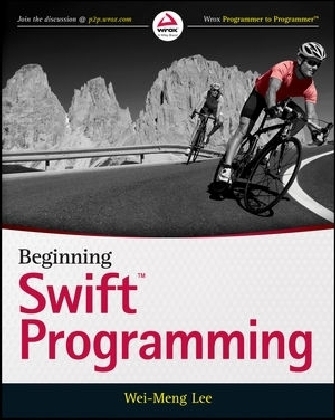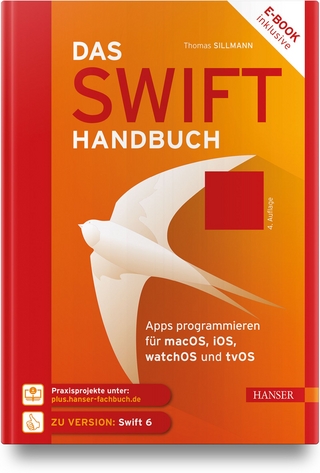
Beginning Swift Programming
John Wiley & Sons Inc (Verlag)
978-1-119-00931-3 (ISBN)
- Titel ist leider vergriffen;
keine Neuauflage - Artikel merken
Beginning Swift Programming is your ideal starting point for creating Mac, iPhone, and iPad apps using Apple′s new Swift programming language. Written by an experienced Apple developer and trainer, this comprehensive guide explains everything you need to know to jumpstart the creation of your app idea. Coverage includes data types, strings and characters, operators and functions, arrays and dictionaries, control flow, and looping, with expert guidance on classes, objects, class inheritance, closures, protocols, and generics. This succinct yet complete overview provides a detailed introduction to the core features of Swift.
Apple developed Swift to address the limitations of Objective–C, and add features found in more complex languages like Python. The results is simpler, cleaner, more expressive code with automatic memory management, functional programming patterns, and more, including built–in features that make Swift apps faster, scalable, and more secure. This book explains it all, helping developers master Apple′s new language.
Become fluent with syntax that′s easier to read and maintain
Understand inferred types for cleaner, less mistake–prone code
Learn the key features that make Swift more expressive than Objective–C
Learn the new optional types in Swift that make your code more resilient
Understand the key design patterns in iOS and Mac OS programming using protocols and delegates
Learn how to use generics to create highly reusable code
Learn the new access controls mechanism in Swift
Get up to speed quickly to remain relevant and ahead of the curve.
Wei–Meng Lee is a technologist and founder of Developer Learning Solutions (www.learn2develop.net), a technology company specializing in hands–on training on the latest mobile technologies. He is an established developer and trainer specializing in .NET, iOS, and Android. Wei–Meng speaks regularly at international conferences and has authored and co–authored numerous books on .NET, XML, and mobile technologies. He writes extensively for the O Reilly Network and Mobiforge.com on topics ranging from .NET to Mac OS X. He is also the author of Beginning iOS 5 Application Development and Beginning Android 4 Application Development, both from Wrox.
INTRODUCTION xxiii
CHAPTER 1: INTRODUCTION TO SWIFT 1
What Is Swift? 2
Why Swift Is Important 3
Setting Up the Environment 3
Creating a Playground Project 4
Creating an iOS Project 6
Swift Syntax 10
Constants 10
Variables 12
String Interpolation: Including Values in Strings 14
Statements 14
Printing 15
Comments 15
Summary 17
CHAPTER 2: DATA TYPES 19
Basic Data Types 20
Integers 20
Types of Integers 21
Integer Operations 22
Integer Literals 22
Floating?]Point Numbers 23
Floating?]Point Operations 23
Floating?]Point Literals 24
Type Alias 25
Boolean 25
Tuples 26
Optional Types 27
Implicitly Unwrapped Optionals 28
Optional Binding 29
Unwrapping Optionals Using ? 30
Enumerations 30
Using Enumeration in Switch Statements 31
Enumeration Raw Values 32
Auto?]Increment for Raw Values 33
Associated Values 34
Enumeration Functions 35
Summary 36
CHAPTER 3: STRINGS AND CHARACTERS 39
Strings 40
Mutability of Strings 40
Strings as Value Types 40
Characters 41
Concatenating Strings 43
Special Characters 44
Unicode 45
Common String Functions 46
Equality 46
Prefi x and Suffi x 47
Length 47
Substrings 48
Converting Strings to Arrays 51
Type Conversion 51
Interoperability with NSString 52
Casting String to NSString 53
Using NSString Directly 54
String or NSString? 55
Summary 56
CHAPTER 4: BASIC OPERATORS 59
Assignment Operator 60
Arithmetic Operators 61
Addition Operator 61
Subtraction Operator 62
Multiplication Operator 62
Division Operator 63
Modulus Operator 63
Increment and Decrement Operator 63
Compound Assignment Operators 65
Nil Coalescing Operator 65
Comparison Operators 66
Equal To and Not Equal To 66
Greater Than or Equal To 67
Less Than or Equal To 67
Range Operators 68
Logical Operators 69
NOT 69
AND 70
OR 71
Combining Logical Operators 71
Ternary Conditional Operator 72
Summary 73
CHAPTER 5: FUNCTIONS 75
Defi ning and Calling a Function 76
Input Parameters 76
Returning a Value 76
Returning Multiple Values 77
Function Parameter Names 77
External Parameter Names Shorthand 79
Default Parameter Values 79
Variadic (Variable) Parameters 80
Constant and Variable Parameters 81
In?]Out Parameters 82
Function Types 83
Defining a Function Type Variable 83
Calling a Function Type Variable 84
Returning Function Type in a Function 85
Nested Functions 85
Summary 86
CHAPTER 6: COLLECTIONS 89
Arrays 90
Mutability of Arrays 90
Array Data Types 90
Retrieving Elements from an Array 91
Inserting Elements into an Array 91
Modifying Elements in an Array 92
Appending Elements to an Array 92
Checking the Size of an Array 93
Removing Elements from an Array 93
Iterating over an Array 93
Creating an Empty Array 94
Testing Arrays for Equality 95
Dictionaries 96
Mutability of Dictionaries 97
Retrieving Elements from a Dictionary 97
Checking the Size of a Dictionary 98
Modifying an Item in the Dictionary 98
Removing an Item from the Dictionary 99
Iterating over a Dictionary 99
Creating an Empty Dictionary 101
Testing Dictionaries for Equality 101
Copying the Behavior of Arrays and Dictionaries 102
Summary 103
CHAPTER 7: CONTROL FLOW AND LOOPING 107
Flow Control 108
If Statement 108
If?]Else Statement 109
Switch Statement 110
Matching Numbers 111
Matching Characters 112
Fallthrough 112
Matching a Range of Numbers 113
Matching Tuples 114
Value Bindings 115
Where Clause 117
Looping 118
For?]In Loop 118
Traditional For Loop 121
While Loop 122
Do?]While Loop 123
Control Transfer Statements 124
Break Statement 124
Continue Statement 126
Labeled Statement 126
Summary 128
CHAPTER 8: STRUCTURES AND CLASSES 131
Structures 132
Memberwise Initializers 132
Structures as Value Types 133
Comparing Structures 135
Classes 135
Defining a Class 136
Properties 136
Stored Properties 136
Lazy Stored Properties 137
Computed Properties 138
Motivation Behind Computed Properties 139
The newValue keyword 140
Read?]Only Computed Properties 141
Property Observers 141
Typed Properties 143
Initializers 144
Initializers and External Parameter Names 145
Initializing Variables and Constants During Initialization 147
Classes as Reference Types 147
Comparing Instances Identity Operators 149
Comparing Instances Equivalence Operators 150
Methods in Classes 151
Instance Methods 151
Local and External Parameter Names for Methods 152
The self Property 154
Type Methods 155
Methods in Structures 155
Summary 157
CHAPTER 9: INHERITANCE 161
Understanding Inheritance 162
Defi ning a Base Class 162
Instantiating a Base Class 162
Creating an Abstract Class 163
Inheriting from a Base Class 164
Overriding Initializers 164
Overloading Initializers 165
Creating Abstract Methods 167
Overloading Methods 169
Preventing Subclassing 170
Types of Initializers 171
Default Initializer 171
Designated Initializers 172
Convenience Initializers and Initializer Chaining 174
Calling Initializers in Subclasses 176
Extensions 177
Extending Methods 177
Extending Properties 177
Access Controls 178
Internal 179
Private 180
Public 181
Summary 181
CHAPTER 10: CLOSURES 185
Understanding Closures 186
Functions as Closures 186
Assigning Closures to Variables 187
Writing Closures Inline 188
Type Inference 188
Shorthand Argument Names 189
Operator Function 190
Trailing Closures 190
Using the Array s Three Closure Functions 190
The map Function 191
Example 1 191
Example 2 192
The filter Function 192
Example 1 192
Example 2 193
The reduce Function 194
Example 1 194
Example 2 195
Using Closures in Your Functions 196
Summary 198
CHAPTER 11: PROTOCOLS AND DELEGATES 201
Understanding Protocols 202
Defining and Using a Protocol 202
Conforming to a Protocol 202
Optional Methods 204
Conforming to Multiple Protocols 206
Property Requirements 206
Initializer Requirements 207
Understanding Delegates 207
Delegates as Event Handlers 208
A Practical Example of Protocols and Delegates 211
Summary 213
CHAPTER 12: GENERICS 217
Understanding Generics 218
Using Generic Functions 218
Multiple Type Parameters 219
Specifying Type Constraint 220
Generic Types 221
Generic Classes 221
Generic Structures 223
Generic Type Extension 224
Using Generics in Protocols 225
Specifying Requirements for Associated Types 228
Summary 229
APPENDIX: EXERCISE ANSWERS 233
INDEX 247
| Erscheint lt. Verlag | 20.2.2015 |
|---|---|
| Verlagsort | New York |
| Sprache | englisch |
| Maße | 185 x 239 mm |
| Gewicht | 488 g |
| Themenwelt | Informatik ► Programmiersprachen / -werkzeuge ► Mac / Cocoa Programmierung |
| Mathematik / Informatik ► Informatik ► Software Entwicklung | |
| ISBN-10 | 1-119-00931-6 / 1119009316 |
| ISBN-13 | 978-1-119-00931-3 / 9781119009313 |
| Zustand | Neuware |
| Informationen gemäß Produktsicherheitsverordnung (GPSR) | |
| Haben Sie eine Frage zum Produkt? |
aus dem Bereich

